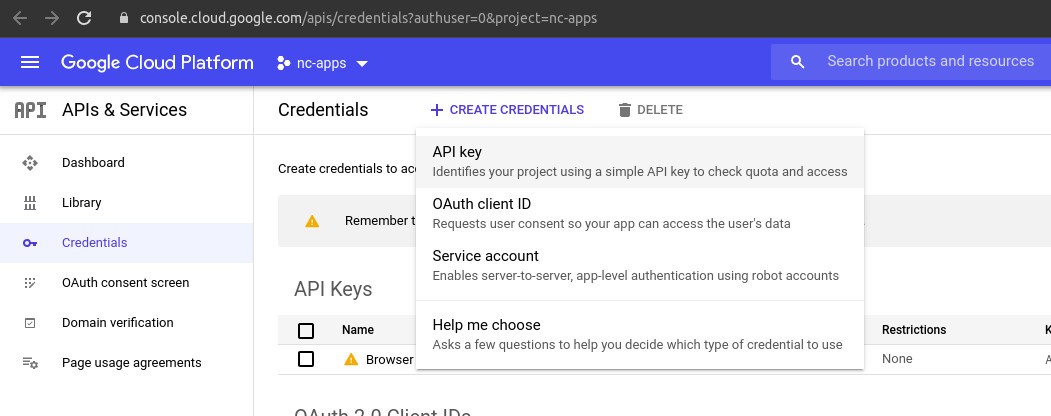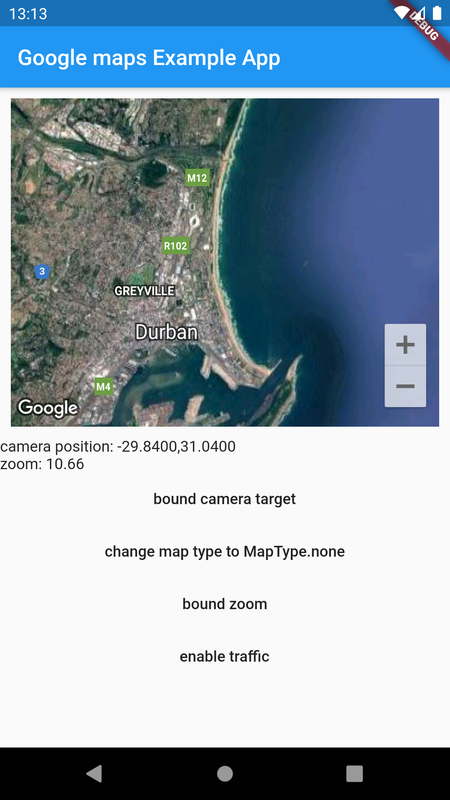In Flutter, google maps can be integrated by using google_maps_flutter package
It provides a GoogleMap widget which can be used to
Import the package into dart code
import 'package:google_maps_flutter/google_maps_flutter.dart';Code snippet of GoogleMap widget
void onMapCreated(GoogleMapController controller) {
setState(() {
_controller = controller;
});
}
static final CameraPosition _kInitialPosition = const CameraPosition(
target: LatLng(-29.84, 31.04),
zoom: 10.66,
);
GoogleMap googleMap = GoogleMap(
onMapCreated: onMapCreated,
initialCameraPosition: _kInitialPosition,
cameraTargetBounds: _cameraTargetBounds,
minMaxZoomPreference: _minMaxZoomPreference,
mapType: _mapType,
trafficEnabled: _trafficEnabled,
onCameraMove: _updateCameraPosition,
);onMapCreated is to assign a callback which gets a GoogleMapController object as argument initialCameraPosition sets the initial latitude & longitude for the camera cameraTargetBounds sets the initial bounds, and if it doesn't contain initialCameraPosition then bounds are based on initialCameraPositionmapType can be MapType.normal, MapType.hybrid, MapType.satellite etconCameraMove assign a callback which gets a CameraPosition object with coordinates of current camera position as argumentCheck Flutter installation to setup Flutter
Use flutter create command to create a Flutter project (here nc_google_maps_app) :
flutter create nc_google_maps_appAdd location package to pubspec.yaml
dependencies:
google_maps_flutter:
flutter:
sdk: flutter
Run following command to add dependency
flutter pub getA API key can be generated from a project under a Google developer account
Go to Google cloud console and log in with a Google account
If not created already, go to https://console.cloud.google.com/projectcreate to create a project
Projects should appear in the top left corner drop-down, including Firebase projects

Select project from the dropdown
Goto https://console.cloud.google.com/google/maps-apis
Alternatively, search for Maps SDK for Android
Click on the Enable button

Go to https://console.cloud.google.com/apis/credentials
Navigate to Create Credentials and click on API key

Copy Api key to be added to manifest

Add Api key as meta-data inside application tag as highlighted
Here NcGoogleMapsApp is React native project name
<application
android:name="io.flutter.app.FlutterApplication"
android:label="nc_google_maps_app"
android:icon="@mipmap/ic_launcher">
<meta-data android:name="com.google.android.geo.API_KEY"
android:value="AIzaSyBg-g9QZMHSmmnPOC-lTC4QnCjClgfTGaI"/>import 'package:flutter/material.dart';
import 'package:google_maps_flutter/google_maps_flutter.dart';
void main() {
runApp(MaterialApp(home: GoogleMapWidget()));
}
class GoogleMapWidget extends StatefulWidget {
GoogleMapWidget() : super();
@override
State<StatefulWidget> createState() => GoogleMapWidgetState();
}
class GoogleMapWidgetState extends State<GoogleMapWidget> {
GoogleMapWidgetState();
final LatLngBounds durbanBounds = LatLngBounds(
southwest: const LatLng(-30, 30.7),
northeast: const LatLng(-29.7, 31.22),
);
static final CameraPosition _kInitialPosition = const CameraPosition(
target: LatLng(-29.84, 31.04),
zoom: 10.66,
);
CameraPosition _position = _kInitialPosition;
bool _isMapCreated = false;
CameraTargetBounds _cameraTargetBounds = CameraTargetBounds.unbounded;
MinMaxZoomPreference _minMaxZoomPreference = MinMaxZoomPreference.unbounded;
MapType _mapType = MapType.normal;
bool _trafficEnabled = false;
GoogleMapController _controller;
@override
void initState() {
super.initState();
}
@override
void dispose() {
super.dispose();
}
Widget _latLngBoundsToggler() {
return FlatButton(
child: Text(
_cameraTargetBounds.bounds == null
? 'bound camera target'
: 'release camera target',
),
onPressed: () {
setState(() {
_cameraTargetBounds = _cameraTargetBounds.bounds == null
? CameraTargetBounds(durbanBounds)
: CameraTargetBounds.unbounded;
});
},
);
}
Widget _zoomBoundsToggler() {
return FlatButton(
child: Text(_minMaxZoomPreference.minZoom == null
? 'bound zoom'
: 'release zoom'),
onPressed: () {
setState(() {
_minMaxZoomPreference = _minMaxZoomPreference.minZoom == null
? const MinMaxZoomPreference(12.0, 16.0)
: MinMaxZoomPreference.unbounded;
});
},
);
}
// Get nextType and assign to button press
Widget _mapTypeCycler() {
final MapType nextType =
MapType.values[(_mapType.index + 1) % MapType.values.length];
return FlatButton(
child: Text('change map type to $nextType'),
onPressed: () {
setState(() {
_mapType = nextType;
});
},
);
}
Widget _trafficToggler() {
return FlatButton(
child: Text('${_trafficEnabled ? 'disable' : 'enable'} traffic'),
onPressed: () {
setState(() {
_trafficEnabled = !_trafficEnabled;
});
},
);
}
@override
Widget build(BuildContext context) {
final GoogleMap googleMap = GoogleMap(
onMapCreated: onMapCreated,
initialCameraPosition: _kInitialPosition,
cameraTargetBounds: _cameraTargetBounds,
minMaxZoomPreference: _minMaxZoomPreference,
mapType: _mapType,
trafficEnabled: _trafficEnabled,
onCameraMove: _updateCameraPosition,
);
final List<Widget> columnChildren = <Widget>[
Padding(
padding: const EdgeInsets.all(10.0),
child: Center(
child: SizedBox(
width: 400.0,
height: 300.0,
child: googleMap,
),
),
),
];
if (_isMapCreated) {
columnChildren.add(
Expanded(
child: ListView(
children: <Widget>[
Text(
'camera position: ${_position.target.latitude.toStringAsFixed(4)},'
'${_position.target.longitude.toStringAsFixed(4)}'),
Text('zoom: ${_position.zoom}'),
_latLngBoundsToggler(),
_mapTypeCycler(),
_zoomBoundsToggler(),
_trafficToggler(),
],
),
),
);
}
return Scaffold(
appBar: AppBar(
title: Text("Google maps Example App"),
),
body: Column(
mainAxisAlignment: MainAxisAlignment.start,
crossAxisAlignment: CrossAxisAlignment.stretch,
children: columnChildren,
),
);
}
void _updateCameraPosition(CameraPosition position) {
setState(() {
_position = position;
});
}
void onMapCreated(GoogleMapController controller) {
setState(() {
_controller = controller;
_isMapCreated = true;
});
}
}Ensure a supported device is connected or emulator is started
Go to project directory
Use flutter run command to run
flutter runIt builds and runs app on an available android/ios device

